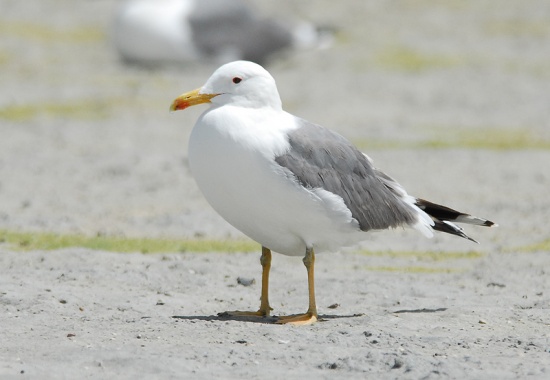m (→Identification: typo) |
(References updated. Video link. OBI link deleted) |
||
| Line 20: | Line 20: | ||
Breeds in central [[Asia]] and north of the Black sea. Winters to [[Europe]], northwest [[Africa]] and south [[Asia]]. | Breeds in central [[Asia]] and north of the Black sea. Winters to [[Europe]], northwest [[Africa]] and south [[Asia]]. | ||
==Taxonomy== | ==Taxonomy== | ||
| − | Three subspecies recognized: | + | ====Subspecies==== |
| + | Three subspecies recognized<sup>[[#References|[1]]]</sup>: | ||
* ''L. c. cachinnans'' breeding from the Black Sea to [[Kazakhstan]], spreads to [[Europe]] after breeding and to northeast [[Africa]] and south [[Asia]] | * ''L. c. cachinnans'' breeding from the Black Sea to [[Kazakhstan]], spreads to [[Europe]] after breeding and to northeast [[Africa]] and south [[Asia]] | ||
* ''L. c. barabensis'' breeds in the steppes of central [[Asia]], winters in southwest Asia and [[India]] - '''Steppe Gull''' (sometimes regarded as full species) | * ''L. c. barabensis'' breeds in the steppes of central [[Asia]], winters in southwest Asia and [[India]] - '''Steppe Gull''' (sometimes regarded as full species) | ||
| Line 31: | Line 32: | ||
They are scavengers and hunt suitable small prey in fields or on the coast, or rob plovers or lapwings of their catches. | They are scavengers and hunt suitable small prey in fields or on the coast, or rob plovers or lapwings of their catches. | ||
==References== | ==References== | ||
| − | #{{Ref- | + | #{{Ref-Clements6thAug11}}#{{Ref-HM03Cor7}}#{{Ref-GillWright08}}#{{Ref-SibleyMonroe96}}#Malling Olsen K and H Larsson. 2003. Gulls of Europe, Asia and North America. London: Christoper Helm. ISBN 0 7136 7087 8 |
{{ref}} | {{ref}} | ||
==External Links== | ==External Links== | ||
[http://www.birdforum.net/showthread.php?t=9361 ID discussion] on how to distinguish Caspian (''L. cachinnans'') and Yellow-legged Gull (''L. michahellis'' and ''L. c. atlantis'') | [http://www.birdforum.net/showthread.php?t=9361 ID discussion] on how to distinguish Caspian (''L. cachinnans'') and Yellow-legged Gull (''L. michahellis'' and ''L. c. atlantis'') | ||
{{GSearch|Larus+cachinnans}} | {{GSearch|Larus+cachinnans}} | ||
| − | + | <br /> | |
| − | [[Category:Birds]][[Category:Larus]] | + | {{Video|Caspian_Gull}} |
| + | |||
| + | [[Category:Birds]][[Category:Larus]] [[Category:Videos]] | ||
Revision as of 19:32, 18 February 2012
- Larus cachinnans
Includes Steppe Gull
Identification
A four-year gull. Slenderer and with a smaller head than Herring Gull. Has a slender, parallel-edged bill and small eyes sitting well forward in head. The neck is long, the breast well protruding and the hindparts slender. Often shows a pronounced hanging-belly behind the long, thin legs.
Adult
Has a similar wing pattern to Herring Gull: White tip to P10, but white tongues on primaries long and often creating a streaked wing-tip. P5 with extensive black markings. The head is white, sometimes with some faint brown hindneck-streaks in autumn. The eye is often darkish-looking, the bill often greenish-tinged. The legs are grey with fleshy to yellow tinge.
Third-year
Like adult but with generally fuller black on wing-tip and often dark markings on primary coverts, tail and bill.
Second-year
Grey upperparts contrast with browner lesser and greater coverts, has a solid dark wing-tip (sometimes with white mirror on P10) and whitish head, underbody and underwing. May show traces of a dark tail-bar.
First-year
White on head and body reduced to spots on hindneck, some faint spots on breast-sides, flangs and edges of undertail-coverts. Bill and eye black. Upperwing brown with solid dark bars across bases of secondaries and greater coverts (like Lesser Black-backed Gull. Tertials dark with white tips. Shows a pale wedge on lower back, reaching the white tail-base which contrasts with the solid blackish tail-bar. Underwing often mainly white.
Similar species
May be confused with Yellow-legged Gull, Herring Gull, Lesser Black-backed Gull and other big gulls.
Distribution
Breeds in central Asia and north of the Black sea. Winters to Europe, northwest Africa and south Asia.
Taxonomy
Subspecies
Three subspecies recognized[1]:
- L. c. cachinnans breeding from the Black Sea to Kazakhstan, spreads to Europe after breeding and to northeast Africa and south Asia
- L. c. barabensis breeds in the steppes of central Asia, winters in southwest Asia and India - Steppe Gull (sometimes regarded as full species)
- L. c. mongolicus from the Altai and Lake Baikal to Mongolia, winters in south Asia - Mongolian Gull (sometimes regarded as full species)
This species is sometimes considered conspecific with Yellow-legged Gull.
Habitat
Breeds on sandy dunes, islands, steppe lakes and along rivers.
Outside breeding season at coasts, in harbours, on lakes or on rubbish dumps.
Behaviour
They are scavengers and hunt suitable small prey in fields or on the coast, or rob plovers or lapwings of their catches.
References
- Clements, JF. 2011. The Clements Checklist of Birds of the World. 6th ed., with updates to August 2011. Ithaca: Cornell Univ. Press. ISBN 978-0801445019. Spreadsheet available at http://www.birds.cornell.edu/clementschecklist/downloadable-clements-checklist
- Dickinson, EC, ed. 2003. The Howard and Moore Complete Checklist of the Birds of the World. 3rd ed., with updates to December 2007 (Corrigenda 7). Princeton: Princeton Univ. Press. ISBN 978-0691117010
- Gill, F and M Wright. 2008. Birds of the World: Recommended English Names. Princeton University Press, Princeton NJ, USA. 2006. ISBN 9780691128276. Update (2008) downloaded from http://worldbirdnames.org/names.html.
- Sibley, CG and BL Monroe. 1996. Birds of the World, on diskette, Windows version 2.0. Charles G. Sibley, Santa Rosa, CA, USA.
- Malling Olsen K and H Larsson. 2003. Gulls of Europe, Asia and North America. London: Christoper Helm. ISBN 0 7136 7087 8
Recommended Citation
- BirdForum Opus contributors. (2024) Caspian Gull. In: BirdForum, the forum for wild birds and birding. Retrieved 19 April 2024 from https://www.birdforum.net/opus/Caspian_Gull
External Links
ID discussion on how to distinguish Caspian (L. cachinnans) and Yellow-legged Gull (L. michahellis and L. c. atlantis)






